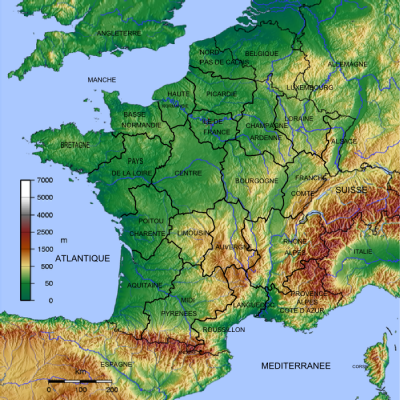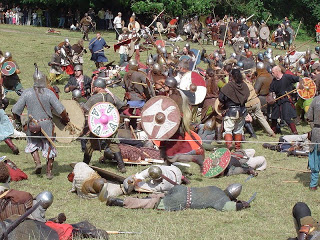
As the Dark Age’s lowest point, France and the rest of Europe fails to defend their people against the Vikings’ ravages. Continuing our series on France’s Wars. Did you ever notice that in almost every great war in history, France has been involved in some way? These stories emphasize the French role in these wars.
SUMMARY: The peoples of Scandinavia achieved naval supremacy over the seas around Europe and across the northern Atlantic to America. They raided, conquered and settled the coastal areas of those lands.
DURATION: 793-1066
BACKGROUND: The Dark Age was on. Unable to mount a naval effort, Europe and Russia lay vulnerable to attack by sea. The Scandinavian countries developed the ultimate in naval warfare for this age, the longboat. With the means to attack at hand, desire followed. Early raids brought back slaves and wealth. Out of the cold of the remote north, the Vikings emerged.
MAJOR COUNTRIES
- France
During the Dark Age, only the greatest of rulers could rule an empire the size of Charlemagne’s. Then he died. The empire was already breaking up when the long boats began pounding the northern coasts. - Scandinavia
The lands of today’s Norway, Denmark, Sweden and Finland were cold and rugged; their people were savage. Life was hard but over the seas a better one beckoned. - Other Realms
Across the Baltic Sea lay the Russians, the Germans, and the other peoples in between. Across the North Sea to the west lay the British Isles and to the south west the western Germans and the Dutch. Further on, the Spanish Peninsula and the lands of the Mediterranean Sea. Before the Vikings were done they colonized Iceland, Greenland, and briefly North America itself.
- France

CC BY-SA 3.0 image from Wikipedia.
NARRATIVE: June 8, 793 was a date that marked Viking infamy. Viking longboats landed on Lindisfame Island and sacked the storied abby. “Never before has such an atrocity been seen,” wrote Alcuin of York.
In subsequent years the Vikings attacked southeast, south, southwest, and west. In 808 they crossed the Baltic Sea and destroyed the main Frankish base at Reric. This gave them undisputed control of the Baltic Sea. They followed up by sailing up the rivers that flowed into it and portaging to the great Rivers of central Russia, such as the Volga. Bands of Vikings reached the Byzantine Court and hired themselves out to the Emperor as the Varangian Guard.
Meanwhile the campaigns against the western territories continued. During the Dark Age the government and society of Europe’s western powers were consolidating into the feudal system. Local warlords were evolving into the aristocracy of later ages. Counts, earls, and dukes emerged with a semblance of rights and obligations. Kings and emperors practical power was limited. Thus large scale operations against the Vikings based upon grand strategies were rare while naval operations were non-existent. This was the opposition the Vikings faced.
In France, the Seine River became a Viking highway with multiple attacks upon Paris. On the west coast of France the Vikings set up a permanent base at the mouth of the Loire River which they used to further their reach to northern Spain. In 844 they conquered Lisbon, Portugal and now the south coast of Spain and the Mediterranean was available.
The Vikings passed from raiding to colonizing. Their colonies extended from Sicily to England which they largely conquered outright. Only the heroic efforts of Alfred the Great kept a part of the island in Anglo-Saxon hands.
By the 900’s the situation was firming up. On the European mainland the Vikings could raid and occupy the coastal areas but the emerging feudal societies of the interiors held out. In France, Charles the Simple ceded the entire peninsula of Normandy to a Viking ruler in 911 with the provisos that the occupiers would swear fealty to the French king, adopt Christianity, and most importantly, resist further Viking incursions.
By the late 900’s Europe’s stiffened resistance negated further incursions. Daring voyages westward got them to Iceland, Greenland, and even Newfoundland in 986. Native resistance in Newfoundland and climate change in Greenland caused the Vikings to pull back to Iceland.
While strife continued for another century, the heyday of the Vikings was over. The Norman invasion of England in 1066, while technically a Viking invasion because Norman the Conqueror was a descendant of them and his army was a mixture of Viking descendants and French descendants, the reasons were dynastic like most of the rest of the wars of Europe rather than the Viking reasons of previous years.
AFTERMATH: The opponent’s counter-attack, if it can be called that, was religious and cultural rather than military. It was probably unintentional for the most part as the Christian missionaries would have believed that they were doing the work of God rather than that of Man. In Denmark Harald Bluetooth Christianized the country around 980. Norway’s conversion was going strong by 1000 and was mostly due to missionaries from England.
The Vikings launched their attacks from homelands which were indeterminate and unorganized. By the close of this age, the areas had kings that governed large areas and these areas were acquiring distinct nationalities. Thus, Norway, Sweden, Finland, and Denmark was born. Europe was transitioning from the Dark Age to the Medieval Age.
| <—Previous | Master List | Next—> |
Further Information: here and here and below.
 |
Like!! I blog quite often and I genuinely thank you for your information. The article has truly peaked my interest.